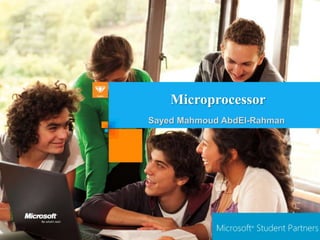
Microprocessor Guide - Features, Types & How to Choose
- 2. Agenda • Introduction. • CPU. • Memory. • I/O Ports. • HW & SW & FW. • What is the Microprocessor? • Kinds of Processors. • Features & Benefits. • Kinds of Desktop & Laptop Processors. • How to Choose the Right Processor.
- 4. Central Processing Unite: • The Central Processing unit or CPU controls the operation of the computer.
- 5. Memory: • Rom (Read only Memory): ROM generally contains permanently stored data that cannot be changed. It can be read but not written into. The main feature of ROMs is that they are non-volatile, which means that the information stored in them is not lost when the power is removed. • Ram (Random Access Memory): RAM is memory that can be read or written to. RAM is actually read/write memory. RAM memory is volatile memory, that is, it is lost whenever the power is switched off.
- 6. I/O Ports: • The input/output or I/O section allows the computer to take in data from the outside world or send data to the outside world. Peripherals such as keyboards, video display terminals, printers and modems are connected to the I/O section. These allow the user and the computer to communicate with each other. The actual physical devices used to interface the computer buses to external systems are often called ports.
- 7. Hardware & Software & Firmware: • Hardware: is the name given to the physical devices and circuitry of the computer. • Software: refers to the programs written for the computer. • Firmware: is the term given to the programs stored in ROMs or in other devices which keep their stored information when the power is turned off.
- 8. What is a Microprocessor ? • The entire CPU with timing and control functions on a single chip is known as Microprocessor. Therefore a Microprocessor or MPU is an integrated circuit that contains many processing capabilities of a large computer.
- 9. Kinds of Processors: • Intel® Itanium® Processor • Intel® Atom™ Processors • Intel® Xeon® Processor • Intel® Core™ Processor
- 10. Features & Benefits: • Intel® Turbo Boost Technology 2.0: dynamically increases the processors frequency as needed by taking advantage of thermal and power headroom when operating below specified limits. • Intel® HT Technology: allows each core of your processor to work on two tasks at the same time. • Intel® HD Graphics 3000: delivers built-in performance for casual and mainstream gaming with no extra graphics hardware needed. • Intel® Quick Sync Video: makes editing and sharing videos simple.
- 11. Bill Gates to be a good professional engineer always start to study late for exams because it teaches you how to manage time and tackle emergencies.
- 12. Kinds of Desktop & Laptop Processors:
- 13. HEROS happen here !!
- 14. Intel® Core i3: • Laptop: Cores/Threads 2/4 Cache 3MB Clock Speed 1.20-2.66 GHz HT technology – HD Graphics • Desktop: Cores/Threads 2/4 Cache 3-4MB Clock Speed 2.5-3.4 GHz HT technology – HD Graphics
- 15. Intel® Core i5: • Laptop: Cores/Threads 2/4 Cache 3MB Clock Speed 1.20-2.66 GHz HT technology – HD Graphics – Turbo Boost technology • Desktop: Cores/Threads 2-4/4 Cache 3-8MB Clock Speed 2.3-3.6 GHz HT technology – HD Graphics – Turbo Boost technology
- 16. Intel® Core i7: • Laptop: Cores/Threads 2-4/4-8 Cache 4-8MB Clock Speed 1.06-2.80 GHz HT technology – HD Graphics – Turbo Boost technology • Desktop: Cores/Threads 4-6/8-12 Cache 8-12MB Clock Speed 2.53-3.50 GHz HT technology – HD Graphics – Turbo Boost technology
- 17. Intel® Core i7 Extreme : • Laptop: Cores/Threads 4/8 Cache 8MB Clock Speed 2.00-2.7 GHz HT technology – HD Graphics – Turbo Boost technology • Desktop: Cores/Threads 6/12 Cache 8-15MB Clock Speed 3.2-3.46 GHz HT technology – Turbo Boost technology
- 18. How to Choose the Right Processor: • How will you use your computer? • How will you enjoy photos and videos? • How will you communicate with other? • What kinds of games will you play? • Which performance you need? • How many program you want run at once time?
- 19. Contact me about.me/sayedmahmoudabdelrahman.com 0111-560-3581 Or search me on the internet just write (Sayed Mahmoud AbdElRahman)
